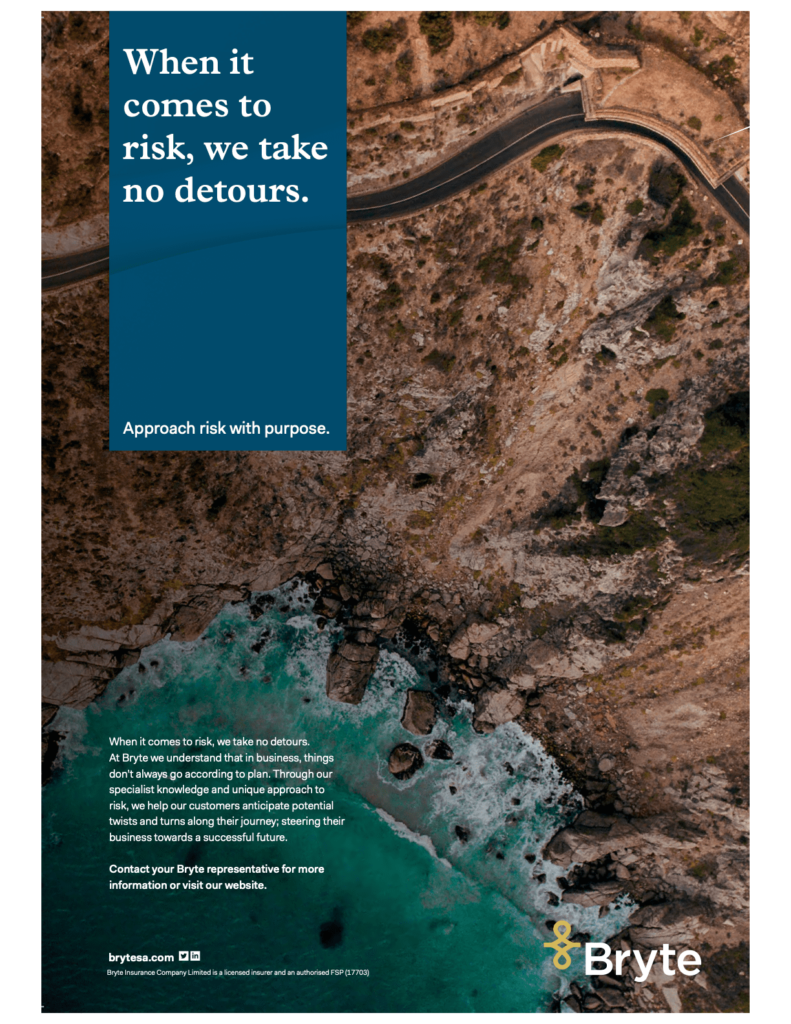JP Blignaut, Chief Underwriting Officer, Bryte Insurance

The COVID-19 pandemic has been a grueling litmus test for the resilience of modern-day society. It has presented us with another year of managing dynamic risk at a pace, keeping business ever more agile as we adjust to unplanned events. With the global pandemic still a looming reality — and vaccine programmes rolling out slower — how we live and engage continue to be impacted. This is why it is essential to pragmatically assess the ongoing and emerging risks that continue to challenge our resilience and ensure that we all consolidate our competencies in a way that provides the ability to forecast and navigate change.
The reliance that businesses have placed on insurers and intermediaries has increased exponentially as company leaders try to build risk mitigation strategies and resilience into their organisations. This has strengthened partnerships across the insurance value chain as we all work to ensure our mutual clients are covered against unforeseen risks and events.
A great example of this is how brokers and insurers worked alongside Sasria to assist businesses severely affected by the unrest in Gauteng and KwaZulu-Natal earlier this year. To date, over R5 billion in claims have been paid out, with effective agreements being brokered to rebuild damaged properties; all to get the economy fully functioning again.
Considering the current socio-economic and political realities, these might not be the last protests our clients’ experience. Therefore, as insurance professionals, we must do more work to evaluate potential risks and put strategies in place to prepare and protect our clients.
Weathering a different, but no less urgent, storm
Nations across the globe are recognising the urgent need to slow down the pace of climate change. COP26 saw several countries committing to initiatives to prevent another 1.5 degrees Celsius increase in temperature — including the landmark agreement between the world’s two most significant economic adversaries, the USA and China. Other commitments include boosting clean energy, alleviating deforestation and working on a transition to a net-zero global economy.
Reports state that as there’s an increase in the warming of the Earth, a larger proportion of the population — approximately 5 billion people — could be exposed to climate hazards that include drought, floods and water stress. And in South Africa, a significant risk that has become hard to ignore is drought. In 2018, the Western Cape government estimated that the province took a R5 billion economic hit due to the impact of the drought on businesses, agriculture and infrastructure.
The likelihood of drought conditions as a regular occurrence is increasing, which increases the potential risk exposure of the agricultural sector — and those who insure it. As such, brokers need to ensure there is a better understanding of the severity of such events and, more importantly, how to manage them proactively. This includes protecting livestock. Water shortages place enormous pressure on farmers to cull their livestock before they become causalities of drought. Loss of livestock places severe financial pressure on farmers, thus making it important to have insurance that can cover losses sustained and avoid insolvency.
Cyber Risks
The number of cyber incidents continues to increase each year, from ransomware to good old-fashioned phishing. As the world digitises, so too do those who make a living from preying on companies and people who have not equipped themselves with effective cyber security measures. With South Africa accounting for the third-highest number of cybercrime incidents worldwide, costing R2.2 billion a year, more effort needs to be placed in safeguarding businesses.
The likelihood of attacks increasing in frequency and severity is high, making it important for insurance professionals to assist clients in understanding how to better protect themselves from a potentially devastating cyber incident. Mitigation measures can include:
- Equipping clients with better information around cyber risk realities and ransomware attacks
- Encouraging clients to invest in more sophisticated IT skills (inhouse or external) and software
- Partnerships with expert institutions that work towards combating this risk and safeguarding businesses
- Getting the right level of cover to protect a business from cyber attacks
A joined-up approach to risk management
Businesses continue to feel the impact of several disruptions including increased load shedding, water shortages and political protests. In light of this, having a joined-up risk management and mitigation plan is essential to reducing the impact of unforeseen events. There is also a greater need to improve the ability to transfer risk away for customers and help them develop strategies to become more proactive in managing and mitigating risks.
Comprehensive risk management will continue to require an invested and effective partnership between insurer, broker and customer. Engagements with a qualified, expert broker help customers forecast and assess the scope and scale of insurance cover required to provide a safety net against risk.
The collaboration between insurer and broker remains a critical component of how clients are futureproofed effectively against risk well into 2022 and beyond.


